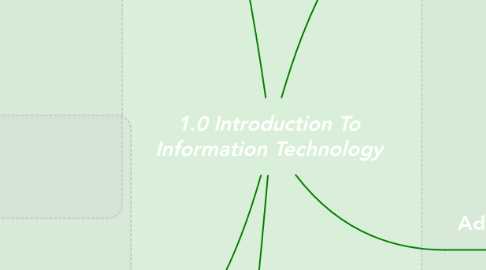
1. Application
1.1. Education
1.1.1. Learning Management System
1.1.2. Computer Based Training
1.2. Finance
1.2.1. Finance Investment System
1.2.2. Online Banking System
1.3. Government
1.3.1. E-filing
1.3.2. E-Syariah
1.3.3. HRMIS
1.4. Health Care
1.4.1. Medline
1.4.2. Counter Registration System
1.4.3. Telemedicine
1.4.4. Telesurgery
1.5. Science
1.5.1. Virtual Reality
1.5.2. Cochlear implant
1.5.3. Hawk Eye Officiating System
1.5.4. Neural network
1.6. Publishing
1.6.1. Online Newspaper & Online Magazine
1.7. Travel
1.7.1. Global Positioning System (GPS)
1.7.2. Online Reservation System
1.7.3. E-Ticketing
1.8. Manufacturing
1.8.1. Computer-Aided Design
1.8.2. Computer Aided Manufacturing
2. Disadvantages
2.1. Violation of Privacy
2.1.1. other person might steal our personal and confidential records if they were not protected properly
2.2. Public safety
2.2.1. we might be victim to crime if we are exposing or sharing out photos, videos or other personal information publicly
2.3. Impact on Labour Force
2.3.1. many employee might jobless because their skill replaced by computer
2.4. Health risk
2.4.1. computers cabn lead to injuries such as back pain and eye sprain if we spend too much time or improper way of using computer
3. Categories
3.1. Supercomputer
3.1.1. Fastest and most powerful computer
3.1.2. capable to process more than one quadrillion instructions in a single second
3.2. Mainframe
3.2.1. Large, expensive, powerful computer
3.2.2. Can handle hundreds or thousands of connected users simulteneously
3.3. Personal Computer
3.3.1. A computer that can perform all of its input, processing, output and storage activity by itself
3.4. Mobile Computer and devices
3.4.1. Mobile computer
3.4.1.1. personal computer you can carry from place to place
3.4.2. Mobile device
3.4.2.1. computing device small enough to hold in your hand
3.5. Embedded Computers
3.5.1. Special purpose computer that is function as a component in a larger product
4. Definition
4.1. The use of computer, hardware and software to store, retrieve and manipulate information
5. Advantages
5.1. Speed
5.1.1. Data, instructions, and information flow incredibly fast speeds
5.2. Reliablity
5.2.1. The electronic components in computers are dependable and reliable because they rarely break
5.3. Consistency
5.3.1. A computer with same input will produce the same results consistently
5.4. Communication
5.4.1. Computers can communicate wirelessly with other computer and allow users to communicate with one another
5.5. Storage
5.5.1. Computers can store enormous amounts of data and make this data available

